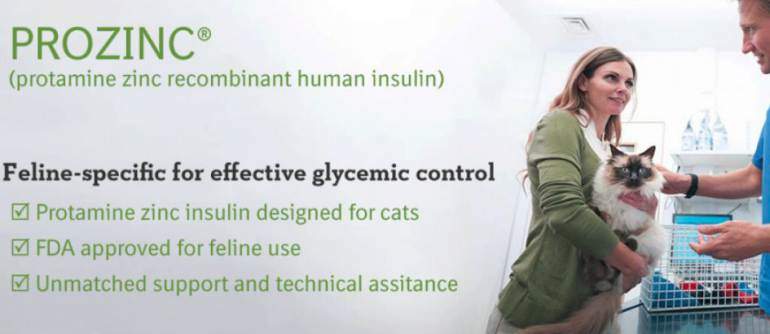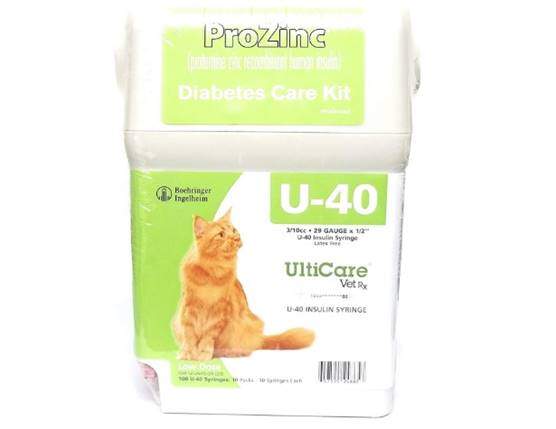What is feline diabetes
Feline diabetes mellitus refers to the inability of a cat to secrete or respond properly to insulin hormone which is produced by the pancreas.
There are two types of diabetes, type I (due to decreased insulin production) and type II (when cells fail to respond to or resists insulin). Both two types are characterized by a spike in blood glucose levels.
Normally, insulin gets attached to cells and signal them at the most appropriate time for them to absorb glucose. As they absorb glucose, “cells in fat deposits, the liver, and the muscles get vital fuel while lowering levels of glucose in the blood”, notes the Cornell University College of Veterinary Medicine.
However, in the case of diabetes mellitus, glucose from blood will not be absorbed and blood sugar levels will be elevated yet this glucose is essential in energy generation.
Symptoms of diabetes
Some of the common clinical signs noted include weight loss, increased thirst, and urination (make urine to be more dilute), among many others.
Diabetes treatments
Treatments range from dietary management to the use of oral drugs to insulin injections. There are various insulin products designed to be used in cats and dogs and they include:
- Porcine insulin zinc suspension – intermediate-acting and FDA approved for dogs and cats
- Prozinc (Boehringer Ingelheim Animal Health) – Long-acting and FDA approved for cats
- Lantus (Sanofi) – long-acting but not approved by the FDA. It is commonly for felines but can also be used on dogs
- Levemir (Novo Nordisk) – Not FDA approved for dogs and cats
With that brief overview, it is time to focus more on ProZinc.
ProZinc insulin for cats

As already stated, ProZinc is long-acting insulin approved by the FDA for cats. It is manufactured by Boehringer Ingelheim and it “a sterile aqueous protamine zinc suspension of recombinant human insulin” notes Drugs.com.
This protamine zinc insulin is indicated to help lower high glucose levels in the blood (hyperglycemia) as well as symptoms that may result due to the elevated glucose level in cats suffering from diabetes mellitus.
It comes in 10ml vial whose concentration is 40 IU/ml and it is recommended for felines that do not respond well to other treatments or those that are newly diabetic.
Finally, it is worthwhile noting that “its safety and efficacy of ProZinc in kittens and inbreeding, pregnant, or lactating cats has not been evaluated, notes its manufacturer Boehringer Ingelheim.
ProZinc insulin dose for cats
The correct dose is between 0.2 – 0.7 IU per kg of cat weight (0.1 – 0.3 IU per pound) administered after every about 12 hours using strictly a U-40 syringe and it should be done after meals. Otherwise, you are likely to end up with the wrong dosage if you use a different type of syringe.
Amazon.com has Boehringer Ingelheim, the ProZinc Diabetes Care Kit that has U-40 3cc 29G x 1/2″, 100 counts of U-40 syringes, a container for disposing of syringes, and brochure with instruction. However, you need a prescription to buy ProZinc.

Its administration is strictly by subcutaneous injection. Do not shake the vial but mix it gently by rolling it. Withdraw it once it appears whitish and cloudy.
In case particles or clumps persist after you have rolled it, do not use it or try to agitate the vial or shake it vigorously.
To come up with the right dosage, your veterinarian should evaluate your cat after some time interval to evaluate glucose nadirs as wells as clinical signs noted until blood glucose is well controlled.
Finally, there may be a need to adjust dosage in case of changes in cat weight, diet, the use of other medications to manage diabetes or in case of other disorders including concurrent infection, neoplasia, and so on.
ProZinc cat insulin prices
In the UK, VioVet sells a 10ml vial at £55 while a pack of ten U-40 syringes goes for £4.99. Chewy sells the same 10ml vial at $112.18 (same as 1800petmeds.com) while the price at Petco is $111.70 both without syringes.
However, buying it from petdrugsonline.co.uk will make a saving since the 10ml vial goes for only £45.3 or at the California Pet Pharmacy which sells it a $95.99.
Additionally, if you buy the vial only, you may be required to buy a Boehringer Ingelheim The ProZinc Diabetes Care Kit, especially in the US at $48.99 on amazon.com or for $36.19 at vetrxdirect.com.
Therefore, the average price for a 10ml vial ProZinc insulin and 10 counts of syringes is between £49-£60 in the UK while in the US it will range from $137 to $161 but will come with a care kit that has 100 counts of syringes.
Side effects of ProZinc for cats
Are there any side effects associated with this insulin treatment for cats and dogs?
Yes. Like any other insulin treatment, ProZinc has some effects both adverse and mild ones. One such adverse effect is hypoglycemia. Therefore, during episodes of hypoglycemia, you should not administer this product.
Note that during hypoglycemia, there might be mild cases of lethargy, trembling, weakness, and uncoordinated behavior. However, there is a possibility of more serious effects such as seizures and coma that are life-threatening. Talk to your vet in case of any side effects.
Finally, keep this medication out of your children’s reach and contact your doctor in case you accidentally inject yourself with ProZinc as it is meant for cats only.
Why should you consider it?
Based on studies, results showed that after six weeks of use of this treatment, the “average blood sugar levels decreased and clinical signs improved, for example, average body weight increased. Based on the main measure of effectiveness 116 out of 139 cats (84%) were considered to be treated successfully,” notes the European Medicine Agency.
Similarly, there have been many testimonials from veterinarians on the efficacy of the use of ProZinc.
